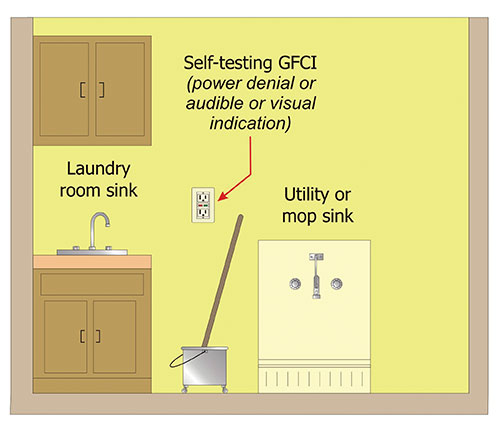Question
I’ve heard GFCIs are now required to have a self-test feature. What is the new GFCIs self-test feature all about? What does it do and does it take the place of the homeowner testing the GFCI every month?
Answer
Effective June 29, 2015, ground fault circuit interrupter (GFCI) receptacles and circuit breakers were required to be manufactured with an auto monitoring or self-test function. This requirement is another step in the continuous improvement of the Standard for Safety for Ground-Fault Circuit Interrupters, UL 943. This new requirement addresses the reality that consumers seldom (if ever) push the “Test” button of installed GFCIs. A past field study revealed a number of devices that were inoperative, prompting the U.S. Consumer Products Safety Commission (CPSC) to request a change in the safety standard to call for technology that, to the extent practical, would not require users to conduct manual tests.

Since their introduction in the 1970s there have been many advances in the design and functionality of GFCIs. Within the last few years the Standard for Safety for Ground Fault Circuit Interrupters, UL 943 has been revised to incorporate enhancements in GFCI design in areas such as improved surge resistance, increased corrosion protection and features that protect against the inadvertent mis-wiring of the line and load connections. All of these changes have advanced the safety of GFCIs.
UL 943 now requires a permanently connected ground-fault circuit interrupter to be provided with an auto-monitoring circuit that will periodically and automatically test the ability of the GFCI. UL 943 also contains new requirements for “power denial” to the GFCI receptacles and any downstream connected devices when the GFCI reaches its end of life. The general requirement in the event of a test failure during the auto monitoring also requires “power denial”. However, there is a special exception for two specific failure modes that allows an audible or visual indication as an alternative. These failure modes open the trip solenoid and open the solenoid driver component and make it impossible for the device to trip with these components open. The improved functionality of the GFCI resulting from the auto monitoring will provide enhanced protection for the consumer against electrical shock hazards.
The auto monitoring or self-test feature periodically tests the electronics from the sensing toroid to the trip solenoid driver and will pick up a failure of the majority of components in the GFCI. It cannot, however, test the trip solenoid driver, the trip solenoid itself or the contacts to see if they are welded. Testing those components can only be done by actually making the GFCI trip. It is not practical to have GFCIs randomly tripping off during self-test cycles. So the manual test button is still provided and it should still be used periodically as recommended. The presence of the self-test function is not allowed to affect the tripping of the device within the specified trip time requirements if an actual ground fault occurs.
GFCI receptacles and circuit breakers manufactured prior to the June 29, 2015, effective date bearing the UL Certification/Listing Mark were not required to meet these new requirements and may still be in the stream of commerce until supplies are exhausted.
UL Certifies (Lists) GFCI receptacles under the product category Ground-fault Circuit Interrupters (KCXS) and GFCI circuit breakers under the product category Circuit Breaker and Ground-fault Circuit Interrupters (DKUY). Both categories and their Certifications/Listings can be viewed on UL Product Spec at www.ul.com/productspec and by entering KCXS or DKUY at the category code search field.













Find Us on Socials